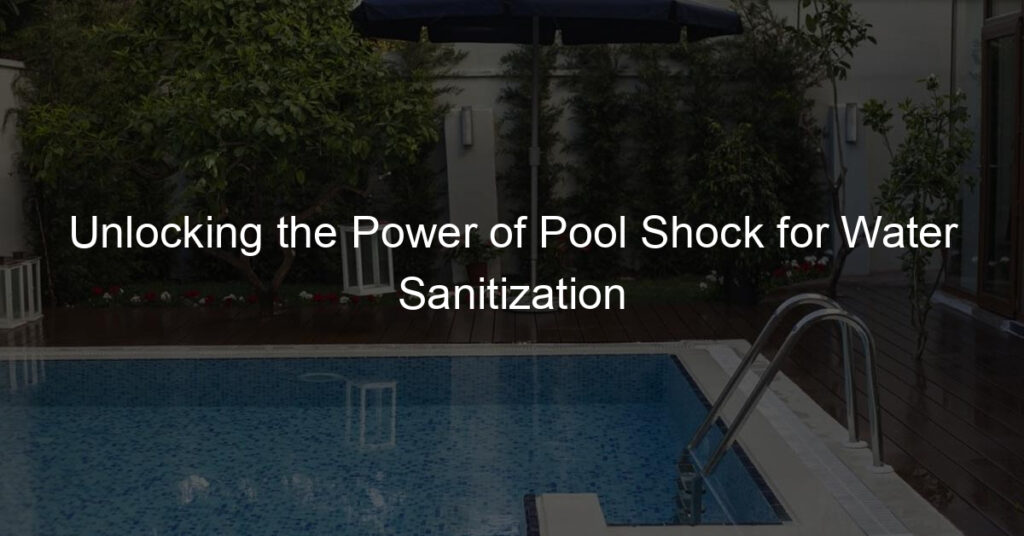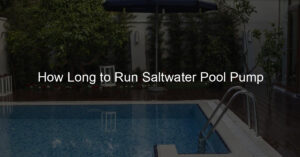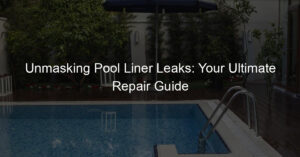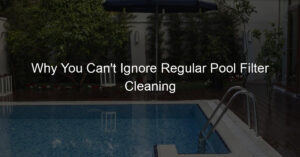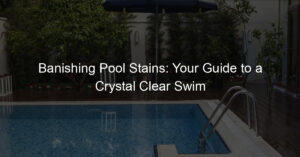Introduction to Pool Shock Treatment
Welcome to our comprehensive guide on pool shock treatment. This process is crucial for maintaining a clean, safe, and healthy swimming pool. Let’s dive in and learn more about this essential pool maintenance task.
- Understanding Pool Shock Treatment
- Importance of Pool Shock in Water Sanitization
Pool shock treatment, also known simply as “shocking,” is a method used to sanitize swimming pools. It involves adding a high dose of chlorine or non-chlorine chemicals to the water. This process kills bacteria, algae, and other organic matter that can cause cloudy water, unpleasant odors, and even health issues for swimmers.
Shocking your pool is not a daily task. It’s typically done weekly or when the pool water appears cloudy or has a strong chlorine smell. It’s also recommended after a heavy rainstorm, a large number of swimmers, or if someone has had an accident in the pool.
The importance of pool shock in water sanitization cannot be overstated. It’s a powerful tool in your pool maintenance arsenal that ensures the water is safe and clean for everyone to enjoy.
Without regular pool shock treatment, harmful bacteria and algae can multiply rapidly, leading to murky water and potential health risks. Shock treatment also helps to break down harmful by-products of chlorine called chloramines, which can cause skin irritation and a strong, unpleasant chlorine smell.
Remember, a clean pool is not just about clear water. It’s about ensuring the health and safety of everyone who uses it. So, make pool shock treatment a regular part of your pool maintenance routine.
Understanding Water Sanitization
Water sanitization is a crucial aspect of maintaining a healthy and safe swimming pool environment. Let’s delve into what water sanitization is and why it is so important, especially in pool maintenance.
What is Water Sanitization?
Water sanitization is the process of removing or killing harmful microorganisms present in water. It is a vital step in ensuring the water we use, especially in swimming pools, is safe and clean.
- Definition and Importance
- Role in Pool Maintenance
Water sanitization is defined as the process of making water safe for human use by removing or killing harmful substances and microorganisms. This process is of utmost importance as it helps prevent the spread of diseases and infections that can be caused by bacteria, viruses, and other pathogens present in untreated water.
In the context of pool maintenance, water sanitization plays a pivotal role. A well-sanitized pool ensures that the water is safe for swimmers and helps maintain the overall health of the pool. It prevents the growth of algae, kills bacteria and viruses, and helps maintain the right chemical balance of the pool water. Without proper sanitization, pool water can become a breeding ground for harmful microorganisms, leading to various health risks for swimmers.
Understanding water sanitization and its importance is the first step towards maintaining a clean and safe pool. In the next sections, we will look at different methods of water sanitization and how they can be effectively used in pool maintenance.
Methods of Water Sanitization
There are several methods to sanitize pool water. Each method has its unique benefits and drawbacks. Let’s explore three popular methods: Chlorine Pool Shock, Non-Chlorine Pool Shock, and UV Sanitization.
-
Chlorine Pool Shock
Chlorine Pool Shock is a common method of water sanitization. It involves adding a large amount of chlorine to the pool to kill bacteria and algae. This method is effective but can cause eye and skin irritation if the chlorine levels are too high. It’s important to test the water regularly to ensure the chlorine levels are safe.
Pros Cons Effective at killing bacteria and algae Can cause eye and skin irritation Easy to use Requires regular water testing -
Non-Chlorine Pool Shock
Non-Chlorine Pool Shock is an alternative to chlorine that is less harsh on the skin and eyes. It works by releasing oxygen into the water to kill bacteria and algae. This method is a good choice for people with sensitive skin or chlorine allergies. However, it may not be as effective at killing certain types of algae.
Pros Cons Less harsh on skin and eyes May not kill certain types of algae Good for people with chlorine allergies Can be more expensive than chlorine -
UV Sanitization
UV Sanitization uses ultraviolet light to kill bacteria and algae. This method is very effective and does not involve adding any chemicals to the water. However, it requires a special UV light system to be installed in the pool, which can be expensive.
Pros Cons Very effective at killing bacteria and algae Requires special equipment No chemicals added to the water Can be expensive to install
In conclusion, the best method of water sanitization depends on your specific needs and budget. Whether you choose Chlorine Pool Shock, Non-Chlorine Pool Shock, or UV Sanitization, regular testing and maintenance are key to keeping your pool clean and safe.
Deep Dive into Chlorine Pool Shock
When it comes to maintaining a clean and safe swimming pool, chlorine pool shock is a term you’ll often hear. But what exactly is it, and why is it so important? Let’s take a closer look.
What is Chlorine Pool Shock?
Chlorine pool shock, also known as super chlorination, is a method used to keep swimming pools clean and safe for use. It involves adding a large amount of chlorine to the water to kill bacteria, algae, and other contaminants.
- Definition and Use
- Benefits and Drawbacks
Chlorine pool shock is a high-dose treatment of chlorine used to sanitize and oxidize a swimming pool. It’s typically used when the pool’s chlorine levels are too low, or when there’s a noticeable problem, like cloudy water or a strong chlorine smell. The shock treatment works by breaking down organic waste and killing bacteria and algae, leaving your pool water crystal clear and safe to swim in.
There are several benefits to using a chlorine pool shock. It’s an effective way to kill bacteria and algae, and it can help to clear up cloudy water. It also helps to remove unpleasant odors and can extend the life of your pool’s filter. However, it does have some drawbacks. For one, it can be harsh on the skin and eyes. It also requires careful handling and storage, as it can be hazardous if not used correctly. Lastly, it can cause damage to the pool’s surfaces if the chlorine levels are not properly balanced after the shock treatment.
Despite these drawbacks, chlorine pool shock remains a popular and effective method for maintaining a clean and safe swimming pool. With careful use and regular testing of your pool’s water, you can enjoy the benefits of a chlorine pool shock without the potential downsides.
How to Use Chlorine Pool Shock
Using chlorine pool shock might seem a bit complicated at first, but with a little practice, you’ll be able to keep your pool sparkling clean. Here’s a step-by-step guide to help you.
- Preparation
- Application
- Post-Treatment Care
Before you start, make sure you have all the necessary equipment. This includes a bucket, a stirring stick, protective gloves, and of course, your chlorine pool shock. It’s also a good idea to wear old clothes, as the chlorine can bleach fabric.
Next, fill your bucket with water. Always add the shock to water, not the other way around, to prevent a dangerous reaction. The amount of shock you’ll need depends on the size of your pool and the current chlorine levels. As a general rule, you’ll need one pound of shock for every 10,000 gallons of water.
Once your shock is prepared, it’s time to apply it to your pool. The best time to do this is in the evening or at night, when the sun won’t burn off the chlorine. Pour the shock directly into the pool, walking around the edge to distribute it evenly. Use your pool brush to stir the water and help the shock dissolve.
Remember, safety first! Always wear your gloves when handling pool shock, and avoid touching your face or eyes.
After shocking your pool, it’s important to give the chlorine time to work. Wait at least 8 hours before swimming. This gives the chlorine time to kill bacteria and algae, and ensures the water is safe for swimming.
Once the waiting period is over, test your pool water to make sure the chlorine levels are safe. If the levels are too high, wait a little longer before swimming. If they’re too low, you might need to shock your pool again.
Remember, a clean pool is a safe pool. Regularly shocking your pool can help keep it clean and safe for everyone to enjoy.
Importance of Pool Cleaning
Keeping your swimming pool clean is more than just about aesthetics. It’s about ensuring the health and safety of everyone who uses it. Let’s dive into the benefits of regular pool cleaning.
Benefits of Regular Pool Cleaning
Regular pool cleaning offers numerous benefits, including health and maintenance advantages. Let’s explore these in more detail.
- Health Benefits
- Maintenance Benefits
First and foremost, a clean pool is a healthy pool. Regular cleaning helps to prevent the growth of harmful bacteria and algae, which can cause skin irritation, eye infections, and other health issues. According to the Centers for Disease Control and Prevention, there were nearly 500 disease outbreaks linked to recreational water use between 2000 and 2014, resulting in over 27,000 illnesses and eight deaths. Regular pool cleaning can help to prevent such outbreaks.
Aside from health benefits, regular pool cleaning also offers maintenance advantages. It helps to prolong the life of your pool equipment, including the pump, filter, and heater. By removing debris and maintaining the correct chemical balance, you can prevent damage to these components and avoid costly repairs or replacements. A study by the National Association of Pool Professionals found that regular maintenance can extend the life of pool equipment by up to 60%.
In conclusion, regular pool cleaning is an essential part of owning a swimming pool. It not only ensures the health and safety of swimmers but also helps to maintain the quality and longevity of your pool equipment. So, make sure to keep your pool clean and enjoy the benefits it brings.
Pool Cleaning Techniques
Keeping your swimming pool clean and clear requires the right techniques. Let’s explore three main methods of pool cleaning.
- Manual Cleaning
- Use a pool net to remove leaves and debris from the water surface.
- Brush the pool walls and floor to dislodge algae and dirt.
- Use a manual pool vacuum to suck up the dislodged debris.
- Test and adjust the water chemistry as needed.
- Automatic Pool Cleaners
- Professional Pool Cleaning Services
- Deep cleaning the pool
- Testing and adjusting water chemistry
- Inspecting and maintaining pool equipment
- Opening and closing the pool for the season
Manual cleaning is a hands-on method that involves using pool nets, brushes, and vacuums. It’s a cost-effective way to maintain your pool, but it requires time and effort. Here’s a simple step-by-step guide:
Automatic pool cleaners are devices that clean your pool without much human intervention. They are a convenient option, especially for busy pool owners. There are three main types:
| Type | Description |
|---|---|
| Suction-side cleaners | These cleaners attach to your pool’s existing pump and filter system, using the suction to move around the pool and pick up debris. |
| Pressure-side cleaners | These cleaners use the pressure side of your pool’s pump to move around and collect debris in a bag. |
| Robotic cleaners | These are the most advanced type. They operate independently of your pool’s system, scrubbing and vacuuming all surfaces of your pool. |
If you don’t have the time or energy to clean your pool, professional pool cleaning services are a great option. These experts have the knowledge and tools to keep your pool in top shape. They can handle tasks such as:
Choosing the right pool cleaning technique depends on your budget, available time, and personal preference. Whether you prefer manual cleaning, automatic cleaners, or professional services, regular pool maintenance is key to enjoying a clean and safe swimming environment.
Swimming Pool Sanitization Process
Keeping your swimming pool clean and safe is a top priority. The sanitization process involves several steps that ensure your pool is free from harmful bacteria and algae. Let’s dive into these steps.
Steps in the Sanitization Process
- Testing the Water
- Adjusting Chemical Levels
- Applying Pool Shock
- Filtering and Cleaning
Before you start the sanitization process, it’s crucial to test the water. This will help you understand the current chemical levels in your pool. You can use a pool testing kit, which will give you readings for pH, alkalinity, and chlorine levels. The ideal pH level for a pool is between 7.2 and 7.8, and the chlorine level should be between 1.0 and 3.0 parts per million (ppm).
Once you have the test results, you can adjust the chemical levels accordingly. If the pH level is too high, you can use a pH reducer. If it’s too low, a pH increaser will do the trick. Similarly, for chlorine, you can add more if the level is low, or dilute the water if it’s too high. Remember, maintaining the right chemical balance is crucial for effective sanitization.
Pool shock is a high dose of chlorine or non-chlorine chemicals that kills bacteria and algae. It’s an essential part of the sanitization process. To apply pool shock, follow the instructions on the package. Generally, you’ll need to dilute it in water before adding it to the pool. Make sure to do this at dusk or night, as sunlight can reduce its effectiveness.
After applying the pool shock, it’s time to filter and clean the pool. Run the pool filter for at least 8 hours to remove the dead bacteria and algae. You should also brush and vacuum the pool to remove any debris. This step ensures your pool is sparkling clean and ready for use.
By following these steps, you can maintain a clean and safe swimming pool. Remember, regular sanitization is key to keeping your pool in top shape. Happy swimming!
Key Takeaways for Effective Sanitization
-
Importance of Regular Testing
Regular testing is a crucial part of maintaining a clean and safe pool. It allows you to monitor the water’s chemical balance, ensuring it’s safe for swimming. For instance, a study by the Centers for Disease Control and Prevention (CDC) found that 1 in 8 public pools had to be closed due to health violations related to improper chemical levels. By testing your pool water regularly, you can avoid such issues and ensure a healthy swimming environment.
-
Correct Use of Pool Chemicals
Using pool chemicals correctly is another key aspect of effective sanitization. Each chemical has a specific purpose, whether it’s to kill bacteria, control algae, or balance the pH levels. Misusing these chemicals can lead to harmful effects, such as skin irritation or even chemical burns. Therefore, it’s important to follow the manufacturer’s instructions and use the correct amounts.
-
Benefits of Regular Sanitization
Regular sanitization has numerous benefits. Not only does it keep your pool looking clean and inviting, but it also prevents the spread of harmful bacteria and diseases. According to the World Health Organization (WHO), regular sanitization can prevent waterborne diseases like diarrhea, cholera, and typhoid. Furthermore, it can extend the lifespan of your pool by preventing the buildup of algae and other harmful substances.
Conclusion: Unlocking the Power of Pool Shock for Water Sanitization
As we wrap up this comprehensive guide, let’s revisit the key points and understand how pool shock treatment can be a game-changer in maintaining a clean and healthy pool.
- Recap of Pool Shock Treatment
- Importance of Regular Pool Maintenance
- Final Thoughts on Pool Water Treatment
Pool shock treatment is a powerful method of sanitizing your pool water. It involves adding a high dose of chlorine or non-chlorine chemicals to the pool to kill bacteria, algae, and other contaminants. This process, also known as ‘super-chlorination,’ helps in breaking down unwanted compounds and restoring the clarity and health of your pool water.
Regular pool maintenance is crucial for ensuring the longevity of your pool and the safety of its users. It includes tasks like skimming off leaves and debris, vacuuming, balancing water chemistry, and shock treatment. Regular maintenance not only keeps your pool sparkling clean but also prevents the growth of harmful bacteria and algae.
Proper pool water treatment is more than just adding chemicals; it’s about understanding the science behind water sanitization and applying it effectively. By unlocking the power of pool shock treatment, you can ensure a safe and enjoyable swimming environment for everyone. Remember, a clean pool is a happy pool!
So, whether you’re a new pool owner or a seasoned pro, we hope this guide has provided you with valuable insights into pool shock treatment and water sanitization. Here’s to many happy and healthy swims ahead!
| Key Takeaways |
|---|
| Pool shock treatment is a powerful sanitization method. |
| Regular pool maintenance is crucial for a clean and healthy pool. |
| Understanding the science of water sanitization is key to effective pool water treatment. |

